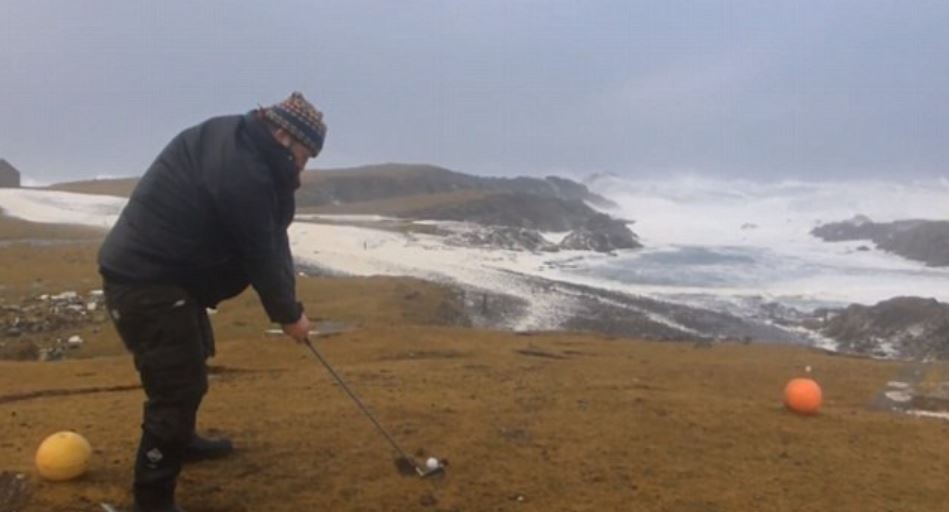How to Play Great Golf in the Wind – Tips & Ultimate Guide

If, like me, you come from the UK or Ireland, you are used to playing golf in the wind. In fact, you sometimes feel a little uneasy on the completely flat-calm days as something just doesn’t feel right. Wind can bring up a whole load of new challenges and it can be one of the biggest tests of a golfer.
No matter where you live, the wind can have a significant impact on your game, so today on the blog we want to help you with some tips that will make it easier to play in the wind. With some simple tweaks, you can gain more control in the breeze. Read on to get one up on gales and wind-proof your game.
What do we consider “windy” in golf?

To me, a windy day on the course is one that is going make me have to think about my shots more because of a breeze. By this I mean, if I have to take extra or less club, if I have to aim differently or spin the ball differently because of a breeze, then it is a windy day. In real terms, that means something of around 10mph or more, which is most days here in Scotland
We golfers need to be constantly surveying our surroundings as we are deciding on what shot to play. If in doubt, toss some grass in the air and you’ll get an idea of the effect the wind will have on your shot.
Tips for Playing in the Wind
Now we will give you some tips to help you manage windy conditions on the course. Try these next time you’re out there and you will see a difference.
Understand Scores Will Rise – Keep Calm
Much of playing golf in the wind is about patience and managing expectations. On a windy day, you need to strike the ball well as this will help the ball battle the wind, if you don’t it can be trouble, but that’s ok. You will make bogies, you just need to brush that off and take advantage of the chances that come your way.
Use More or Less Club
One of the best things you can do in the wind is to slow the tempo of your swing right down. This helps reduce the backspin on the ball and will help it fly into the breeze. By taking more club and swinging slowly, you will see much better results. The same goes for playing downwind, take less club and use the breeze to your advantage.
Play Strategically

Too often, golfers try to play the hero shot or one that most of the time they just won’t pull off. In the wind it is especially important to play “percentage golf” and reduce risk as much as possible. By keeping your ball on the short stuff, playing tactically and strategically, you will end up with a better score.
1. Take Fewer Risks
Like the point above, one of the best ways to implement this is to aim at the middle of the green instead of flags or hit irons from the tee more. This all means that you have far more margin for error and that the wind can affect your ball more without it punishing you. In many ways, the wind calls for you to play “boring golf”, but this will help you win.
2. Keep the Ball Low
We’ve all done it, you hit a shot into the wind and it balloons up into the air, it goes nowhere. Keeping the ball low means taking as much spin off of the ball as possible and that can only be achieved with a nice slow, smooth swing. Many golfers try to hit it harder in the wind, that’s the worst mistake you can make, in the breeze, swing with ease.
3. Tee the Ball Lower
This seems like logic, but have you heard of “gear effect”? This means that a ball teed low will tend to have more spin imparted on it and it will struggle far more into the wind as wind amplifies spin. This means that you could actually do well by teeing it up into the wind, it’s a strange idea but give it a shot.
4. Ball Back, Weight Forward
By moving your ball position back and putting your weight forward, you can create a lower launch to help fight the wind. This effectively reduces the loft on the club however, it can lead to increased backspin so you need to think about sweeping the ball off the turf. This set-up with a slow and shallow swing will help you battle the breeze.
5. Use the Punch Shot
The stinger is the king of the wind-beater shots but the punch shot is the first step to learning that shot. The section above is the basis of the shot, ball position goes back a little and your weight goes forward, then you want an abbreviated swing. Think about taking the club from “shoulder to shoulder” in order to sweep the ball nicely and kill the spin.
6. Give Yourself More Room if you Play with a Draw or a Fade
Many of you will know what happens to any sort of shaped shot in the wind, it becomes very amplified. This means that you have to consider your landing zone when you are hitting your shots, you really must play for where the space is. The biggest punishment that the wind can dish out is the lost ball, avoid that and your scores will benefit immediately.
FAQ

How do I keep the ball low in the wind?
In the breeze, swing with ease. I’ve already used that rhyme but it is one that I am constantly reminding myself of during a windy round. Slowing your tempo down has multiple benefits to your game in the wind.
Firstly, it helps reduce back spin and will give you a more boring flight (not fall asleep boring, able to bore through the wind boring). Secondly, and arguably more importantly, it can really improve your ball striking which is vital on windy days. A solid strike will penetrate the far more effectively and help keep big mistakes from affecting your score.
Does wind affect putting?
It absolutely can, this is why links courses tend to have slower greens as if they were too fast the wind would wreak havoc on putting. A mild breeze won’t do too much to your putts but when it gets up, you really have to factor it in to your line and pace. On fast greens, a wind speed of even 10mph can affect your ball on the putting surface.
You should also change your set-up on windy days to maximise your performance. Widening your stance is a highly recommended adjustment as this gives you a more stable base and will prevent you from being moved by the wind. Finally, stay patient, you may make more mistakes when putting in the wind but getting annoyed won’t help it.
How to hit a driver into the wind?
Normally, your weight should be behind the ball when you’re hitting a driver to create that high launch with low spin. For a tee shot into the wind, you want to bring some of that weight more onto the front foot to reduce your dynamic loft at impact. This will lower your launch angle straight away.
Another thing you can do is to concentrate on keeping the driver head low through impact. Finally, and I know I’m repeating myself, swing it nice and easy. This combination will create low fairway-seeking drives that will help you beat the wind.
How much does a 20 mph wind affect a golf shot?
Judging what wind will do to your ball means it is time for some simple maths. A general rule is to add 1% of the distance on to shots into the wind and to remove 0.5% for shots down wind. This is all well and good but what if you don’t actually know the wind speed.
Try to test it on the range and see what is happening to your shots during your warm-up. Also, trust your judgement, you will be amazed at how good you can be at judging wind, especially if you’ve been playing a long time. Let your experience shine and you may surprise yourself.
Can I play golf in 30 mph winds?
Yes, you can, any links player will be happy to tell you that this is possible. When the wind gets this severe, you have to stop trying to fight it and start going under it or using it. For example, highly skilled players can reduce the effect of a crosswind using spin.
In a right-to-left wind, you could hit a strong fade to balance out the effect the wind has on the ball. If you don’t think you are that consistent in your shot shaping, learn to hit the ball nice and low. This is the easiest way to play in the windiest of conditions.
At what wind speed is golf unplayable?
Frankly, even with what is said above, winds of 20 mph are going to be tough and demand exacting ball striking. As we move closer to 30 mph it becomes extremely difficult and beyond that will be next to unplayable.
You can play in really any wind, it’s just whether it is worth being out and if you’ll get any enjoyment at all. In terms of competition golf, when the ball just won’t sit still on the green or if it is actually dangerous to be out, that’s when the wind will stop play.
When is it too windy for the driving range?
The driving range isn’t too different to the course in terms of when is wind too much of a factor but it also depends what your practice session is for. If you are working on some swing mechanics and want to get reps in for a new move then the wind doesn’t matter so much. If you’re working on shape, distance control or flight then even 15 mph could be too much.
Importantly, if you have the option, hit balls into the wind. This will show you just how good you’re really hitting the ball. There is no hiding from a strong headwind.
How much does side wind affect the ball?
In my opinion, a side wind is one of the hardest conditions to play in. Wind is never constant, it’s more often gusty and this is where it gets tough. When you’re playing into or down wind, you could be a few yards out in length and usually that’s ok.
However, a side wind can just gust your ball away from your target and if you have side spin and a wind in that direction, it’s real trouble. Gusting side winds will test your patience like nothing else in golf.
How do you calculate wind speed on the course?
You may have seen a golfer deep in thought looking at the top of trees, wandering to get a view of a flag or even through some grass in the air. They’re not losing it, don’t worry, they are looking for clues for the wind direction. You can feel it but all of the things listed above give clues. You need to have a look around sometimes as trees can shield you from the real breeze that will affect your ball.
One thing I like to do is just check the local weather report for the course. Modern technology affords us this luxury and that serves me as my foundation for what to expect. I then get on the course and adjust my wind compensation according as the day progresses and I settle into my round.
Conclusion

There is something about a really windy round, a tough challenge, when you are out there with good friends. You’ve spent a few hours being battered by the breeze, you’ve played some great shots and you’ve also played some bad. Then you get into the clubhouse and the noise stops, it’s an eerie calm.
When you get your hands on a pint in the clubhouse after this kind round it always tastes even better. Don’t let the wind hold you back, use the tips above to fight it and it will make you a tougher golfer.
Check Out Our Articles On Playing Golf In The Winter And Playing Golf In The Rain Here.



